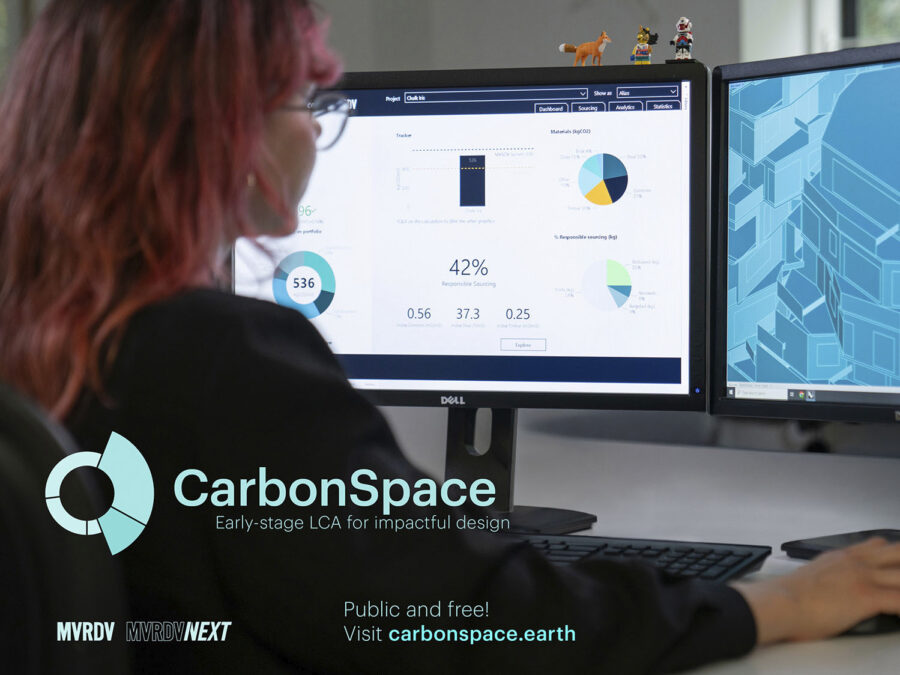
CULTURE


© Ossip

© Ossip
オランダ・アムステルダムに、中庭に水を引き込む水上集合住宅〈SLUISHUIS〉が完成しました。典型的な中庭型建築をベースとした、都市部と水の風景をつなぐ集合住宅です。
気候変動を受け海外、特にヨーロッパで水と建築のあり方を問うプロジェクトが増えている中、ビャルケ・インゲルス(Bjarke Ingels)が率いるビャルケ・インゲルス・グループ(Bjarke Ingels Group、以下BIGと表記)が設計した建築です。
(以下、BIGから提供されたプレスキットのテキストの抄訳)

© Ossip

© Ossip
アムステルダムの端にある密集した都市と広大な風景の間に〈SLUISHUIS〉は位置する。また、大規模なインフラとそれに付随する小規模な市街地という複雑な環境により形成された建築である。
〈SLUISHUIS〉は典型的な中庭型の建築をベースに、水上生活という概念を取り入れている。

Diagram

Diagram
この中庭型建築の市街地側に段差をつけたテラスを配置することで、街並みから自然へとスムーズに移行できるようにしている。
また、湖側を持ち上げることで、湖の水を中庭に引き入れるとともに住居に日差しと眺望をもたらしている。
この2つの変形により、どの角度から見ても異なる表情をもつ建築とる。

Diagram

Diagram
BIGの創業者であるビャルケ・インゲルス(Bjarke Ingels)は次のように語る。
「まちに対して建物の高さを下げることで訪問者を屋根に登らせ、湖に面したパノラマビューを楽しむように誘う。」
「水面に対しては建物を持ち上げることで巨大なゲートとなり、船が入港できる港となる。港の中に建物があり、建物の中に港があるのである。」

© Ossip
建物の周囲にはプロムナードがあり、ハウスボート、ヨットスクール、フローティングガーデンといったさまざまなプログラムを結びつけ、水上のコミュニティを形成している。
建物を登るパブリック・パサージュは小さな屋上ストリートとして機能し、最上階では湖を見渡す展望台となる。
このパサージュは、訪問者や近隣住民のための行楽地となるだけでなく、住戸同士を結びつけ、居住者間のユニークな三次元的コミュニティを創出するものである。

© Ossip
BIGのパートナーであるアンドレアス・クロック・ペダーセン(Andreas Klok Pedersen)は次のように語る。
「世界的に有名なアムステルダムの都市環境は、水と都市の融合によって生み出された。〈SLUISHUIS〉はそのDNAを引き継ぎ、水と都市を融合させることで、都市の生活スタイルの可能性を広げるものである。」

© Ossip

© Ossip
〈SLUISHUIS〉のシルエットは、建物の周囲を移動するにつれて変化する。
ある視点からは、眼下に広がる水面を映す船首のように見え、別の視点からは、訪問者を巻き込む縦方向のコミュニティとして見える。
そして、住民や近隣住民だけでなく、アムステルダムの市民が楽しめるよう、交通アクセスやまちの賑わいを備えた真の都市ブロックとして見えるのである。

SIte

Site

Siteplan

Plan

Elevation

Elevation

Elevation

Elevation

Section

Elevation Detail
以下、BIGのリリース(英文)です。
PROJECT DATA
Name: SLUISHUIS
Code: SLUIS
Date: 13/07/2022
Program: Housing
Status: Completed
Size in m²: 46000
Project type: Competition
Client: VORM / BESIX
Collaborators: Barcode Architects, Van Rossum, Buro Bouwfysica, DWA, Klimaatgarant
Location Text: Amsterdam, The NetherlandsPROJECT TEAM
Partners in Charge: Bjarke Ingels, Finn Nørkjær, Andreas Klok Pedersen
Project Manager: Jeppe Langer
Concept Design Leads: Dimitrie Grigorescu, Jan Magasanik
Team: Mads Engaard Stidsen, Olly Veugelers, Yulong Li, Dominika Trybe, Lone Fenger Albrechtsen, Anna Odulinska, Sascha Leth Rasmussen, Frederik Skou Jensen, Nina Vuga, Jean Valentiner Strandholt, Justyna Mydlak, Yu Xun Zhang, David Vega y Rojo, Hessam Dadkhah, Alex Bogdan Ritivoi, Dominika Trybe, Kirsty Badenoch, Yannick Macken, Vinish Sethi, Santtu Johannes Hyvärinen, Kirsty Badenoch, Mads Mathias Pedersen, Jonas Aarsø Larsen, Daniel Ferrara Bilesky, Helen Shuyang Chen, Gokce Naz Tercioglu, William Pattison, Keuni Park, Shengpeng Mao, Sherief Al Rifal, Luca Pileri, Anna Bertolazzi, Frederikke Faas, Filip Radu, Simone van de Wiel, Hongduo Zhou, Jagoda Helena Lintowska, Victoria Ross-Thompson, Sebastian Liszka, Brage Mæhle Hult, Martino Hutz, Dina Brændstrup, Sze Ki Wong, Kristoffer Negendahl, Christian Eugenius Kuczynski, Arielle Khosla, Andrea Angelo Suardi, Borko Nikolic, Kim Christensen, Birgitte Villadsen
BIG Landscape: Ulla Hornsyld, Louise Natalie Mould, Manon Otto, Anne Katrine Sandstrøm, Paola Yepes Bocanegra, Camille Inès Sophie Breuil, Lasse Ryberg Hansen
BIG Engineering: Duncan Horswill
BIG Sustainability: Tore BankePROJECT DESCRIPTION
Located between the dense city and the vast landscapes on the edge of Amsterdam, the new Sluishuis is shaped by its complex surroundings at once close to large infrastructure and to small-scale urban settlements. The classical courtyard building is revitalized by two transformations; it fully embraces the idea of living on the water and appears different from every vantage point. Toward the water the block is lifted up, forming a large opening that brings water from the IJ Lake into the courtyard and brings daylight and views to the complex’s inner apartments. Toward the neighboring urban district the block steps down like a cascade of landscaped terraces, creating a natural transition from cityscape to smallerscale, natural surroundings.
“Having spent my formative years as an architect in Holland at the end of the 20th century, it feels like a homecoming to now get to contribute to the architecture of the city that I have loved and admired for so long. Our Sluishuis is conceived as a city block of downtown Amsterdam floating in the IJ Lake, complete with all aspects of city life. Towards the city, the courtyard building kneels down to invite visitors to climb its roof and enjoy the panoramic view of the new neighborhoods on the IJ. Toward the water, the building rises from the river, opening a gigantic gate for ships to enter and dock in the port/yard. A building inside the port, with a port inside the building.” Bjarke Ingels, Founding Partner, BIG.
A promenade with public programs winds around the building and continues into the water, forming an archipelago of islands with houseboats, a sailing school, and floating gardens. A public passage climbs the cascading terraces of the building, serving as a small rooftop street that eventually loops onto the very top of the building to create a viewing platform over the IJ Lake. The passage will not only create adestination for visitors and neighbors, but will connect the residential units to each other and create a unique three-dimensional community between the residents of the building.
“The world famous urban environment of Amsterdam was created by the fusion of water and city. The new Sluishuis is born of the same DNA, merging water and perimeter block and expanding the possibilities for urban lifeforms around the IJ.” Andreas Klok Pedersen, Partner, BIG.The silhouette of Sluishuis will change as one moves around the building. At one vantage point it appears as the bow of a ship that reflects the water below; at another a vertical green community that invites visitors to engage directly with it; and finally as a true urban block with street access and city liveliness that is to be enjoyed by residents, neighbors, and the rest of Amsterdam.
BIG 公式サイト









